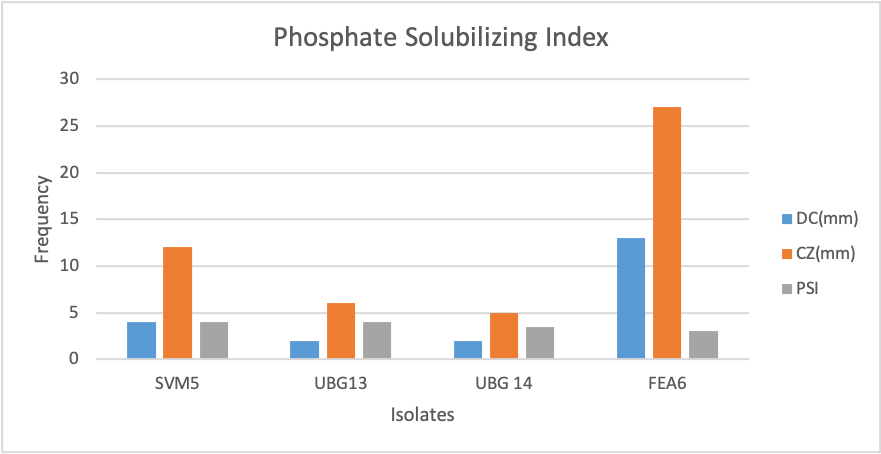Phosphate solubilization by rhizobacteria isolated from the rhizosphere of Mimosa pudica: an investigation into microbial mobilization of phosphorus
Keywords:
Phosphate, Solubilization, Rhizobacteria, Rhizosphere, Mimosa pudicaAbstract
Phosphorus (P), in addition to nitrogen (N) and potassium (K), makes up the essential macronutrients needed by plants for growth and development. P is also one of the most abundant elements present in the Earth’s crust, and it occurs in both organic and inorganic forms. Although present in high concentrations, only a very minute amount is bioavailable to plants because of its poor solubility due to its high binding affinity to calcium, aluminium, and iron in the soil, forming insoluble calcium phosphate, aluminium phosphate, and ferrous phosphate, thereby becoming recalcitrant for plant utilization. In this study, bacteria isolated from the rhizosphere of Mimosa pudica from different locations at Nnamdi Azikiwe University, Awka, were screened for their ability to solubilize phosphate using point inoculation on Pikovskaya (PVK) media agar plates with tricalcium phosphate (Ca3(PO4)2) as a source of phosphate. The result showed that of the twenty-one (21) rhizobacteria screened, four (4) were able to solubilize phosphate with varying phosphate solubilizing index (PSI). The degrees of PSI were in the following order: isolate SVM5 and UBG13 > isolate UBG14> isolate FEA6. Isolate SVM5 and UBG13 had the highest PSI of 4.0, while isolate FEA6 had the lowest PSI of 3.1. The biochemical tests of the isolates revealed that the phosphate-solubilizing bacteria were members of Klebsiella spp. (FEA6, SVM5, and UBG14) and Pseudomonas sp. (UBG13). This study, therefore, suggests the need to include rhizobacteria as part of biofertilizer formulations to improve plant yield via the solubilization of phosphate into forms that are bioavailable for plant growth.

Published
How to Cite
Issue
Section
Copyright (c) 2025 Ray Niofunimbi Izomor, Peace Chidimma Nwankwo, James Ogochukwu Okafoanyali

This work is licensed under a Creative Commons Attribution 4.0 International License.
How to Cite
Similar Articles
- C. E. Achikanu, I. I. Ujah, O. N. Ani, C. A. Nsude, K. O. Okolo, D. O. Okeke, C. U. Ekekezie, V. E. Okpashi, L. C. Okwesili, I. O. Okpako, E. O. Nneji, C. A. Anieke, Environmental degradation of Nike lake: a study on water quality parameters and heavy metal accumulation in fish , African Scientific Reports: Volume 3, Issue 3, December 2024
- Emmanuel B. Oluwagbemi, Victor N. Enwemiwe, Ebenezer O. Ayoola, Clement C. Obi, John U. Okushemiya, Hilda Ufoegbune, Physicochemical characteristics of soil and water in electronic waste dump site, Alaba Lagos, Nigeria , African Scientific Reports: Volume 2, Issue 1, April 2023
- Anthony E. Aiwonegbe, Odunayo D. Adeyemi, Faith I. Akhidenor, Physico-chemical, heavy metal, and microbiological analysis of effluent from a confectionery company in Lagos State, Nigeria , African Scientific Reports: Volume 4, Issue 3, December 2025 (In Progress)
You may also start an advanced similarity search for this article.




